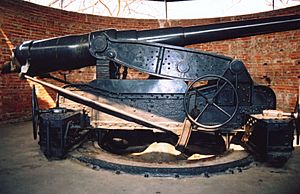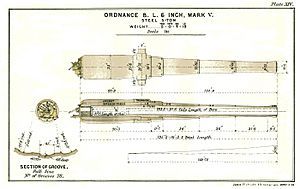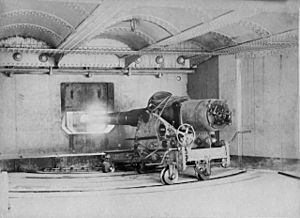BL 6-inch gun Mk V facts for kids
The BL 6 inch gun Mk V was a powerful type of artillery gun. It was made by the Elswick Ordnance Company in the United Kingdom. This gun was designed to protect coastlines around the British Empire. It was used from 1884 until 1945. These guns were special because they loaded from the back (breech-loading). They were also designed to use older types of gunpowder.
Quick facts for kids Armstrong BL 6-inch 30 calibre gun |
|
|---|---|

Disappearing gun at Fort Chulachomklao, Thailand
|
|
| Type | Coast defence gun |
| Place of origin | United Kingdom |
| Service history | |
| In service | 1884 - 1945 |
| Used by | United Kingdom Australian Colonies New Zealand Siam Romania |
| Production history | |
| Designer | Elswick Ordnance Company (EOC) |
| Manufacturer | EOC |
| Unit cost | £3,400 |
| Specifications | |
| Mass | 5 tons barrel & breech |
| Barrel length | 183.5 inches (4,661 mm) bore (30.58 calibres); 192 inches (4,877 mm) bore and chamber (32 calibres) |
|
|
|
| Shell | 100 pounds (45.36 kg) |
| Calibre | 6-inch (152.4 mm) |
| Breech | 3 motion interrupted screw. Elswick cup obturation |
| Muzzle velocity | 1,890 feet per second (576 m/s) |
| Maximum firing range | 8,000 yards (7,300 m) 8,530 yards (7,800 m) (Romanian service) |
Contents
What Was the BL 6-inch Gun Mk V?
This gun was designed by the Elswick Ordnance Company. It was different from other British naval guns of its time. The Mk V gun was longer, measuring 30 calibres (about 183.5 inches) in its main barrel. It could fire a 100-pound projectile.
The gun was built using strong steel parts. It had a steel inner tube surrounded by many steel hoops. This made the gun very strong and durable.
The British government bought some of these guns for defending their own coasts. They were called the 6-inch gun Mark V. Some parts of the gun were changed to match other British guns. For example, the way the breech (the back part where the shell is loaded) locked was different.
The inside of the barrel had 28 special grooves. These grooves made the shell spin as it left the gun. This spinning helped the shell fly straight and hit its target.
Where Were These Guns Used?
These guns were sent to many places around the world. They were used for coast defence in:
- Hong Kong
- New Zealand
- Australian colonies
- Siam (now Thailand)
Often, these guns were set up as disappearing guns. This meant they could pop up to fire and then hide again. This made them harder for enemies to target.
Romania also bought 10 of these guns. They used them during the First World War. The guns used by Romania could shoot even further, up to 7,800 meters (about 8,530 yards).
How Were Some Guns Updated?
In the 1890s, a new way of loading guns became popular. This was called "QF" technology. It used brass cases for the propellant (the stuff that makes the gun fire). This made the guns fire much faster.
Four of the Mk V guns were sent back to the UK from Australia. They were changed to use this new "QF" system. These updated guns were called "QFC" guns.
Two of these QFC guns were still being used as late as 1945. They were part of the defences at Albany, Western Australia. They helped protect the port during World War II.
Image gallery
See also
- List of coastal artillery
Where Can You See Surviving Guns?
You can still see examples of these historic guns today:
- Seven disappearing guns are at Chulachomklao Fort, Bangkok, Thailand. See File:Armstrong cannon, Chulachomklao fort.jpg
- A Mk V gun on a recreated disappearing mount is at Fort Lytton National Park, near Brisbane, Queensland, Australia. See also [1]
- A Mk V disappearing gun, restored in 1998, is at Taiaroa Head, Dunedin, New Zealand. See File:Disappearing Gun Taiaroa Head.jpg
- An Armstrong Mk V gun is on the North Shore, Auckland, New Zealand. It used to be at Fort Bastion. See [2]
- An unrestored Mk V disappearing gun is at Fort Jervois, Ripapa Island, New Zealand. See [3]






